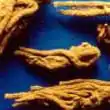Angelica sinensis
Angelica sinensis, commonly known as dong quai (simplified Chinese: 当归; traditional Chinese: 當歸) or female ginseng, is a herb belonging to the family Apiaceae, indigenous to China. Angelica sinensis grows in cool high altitude mountains in China, Japan, and Korea. The yellowish brown root of the plant is harvested in the fall and is a well-known Chinese medicine which has been used for thousands of years.[3]
| Angelica sinensis | |
|---|---|
 | |
| Scientific classification | |
| Kingdom: | Plantae |
| Clade: | Tracheophytes |
| Clade: | Angiosperms |
| Clade: | Eudicots |
| Clade: | Asterids |
| Order: | Apiales |
| Family: | Apiaceae |
| Genus: | Angelica |
| Species: | A. sinensis |
| Binomial name | |
| Angelica sinensis | |
| Synonyms[2] | |
| |
Pharmacology
Growing environment
Angelica is a low-temperature and long-sunshine crop, suitable for cold and cool climate, and can be cultivated at an altitude of 1500-3000m. The rate of lichen extraction is high in the low sea area. The seedling stage is shade-loving and the transmittance is 10%. Seedlings need to be kept out of direct sunlight, but the mature plant can withstand it. The growth of angelica should be cultivated in sandy loam with deep soil layer, loose soil, good drainage, and rich humus, not in low-lying water or easily hardened clay and barren sandy soil.[4]
Traditional Chinese medicine
The dried root of A. sinensis – commonly known as Chinese angelica (Chinese: 當歸; pinyin: dāngguī; Pe̍h-ōe-jī: tong-kui) – is widely used in traditional Chinese medicine, although there is insufficient evidence that it has any medicinal effect.[5]
Adverse effects
There is evidence that A. sinensis may affect the muscles of the uterus. Women who are pregnant or planning on becoming pregnant should not use A. sinensis, because it may induce a miscarriage.[5] Taking A. sinensis can cause skin to become extra sensitive to the sun, leading to a greater risk for skin cancer.[5] One case of gynaecomastia has been reported following consumption of dong quai root powder pills.[6]
Drug interactions
A. sinensis may increase the anticoagulant effects of the drug warfarin (as it contains coumarins[7]) and consequently increase the risk of bleeding.[8]
Due to the antiplatelet and anticoagulant effects of A. sinensis, it should be taken with caution with herbs or supplements (such as ginkgo, garlic, and ginger) that may slow blood clotting to reduce the possible risk of bleeding and bruising.[5][9]
Chemistry
The plant's chemical constituents include phytosterols, polysaccharides, ligustilide, butylphthalide, cnidilide, isoenidilide, p-cymene, ferulate, and flavonoids.[10] When isolated from the plant, one of the chemicals, angelica polysaccharide sulfate, has in vitro antioxidant activity.[11]
See also
- Angelica
- Chinese herbology
- Scutellaria baicalensis (Baikal skullcap)
- Eleutherococcus senticosus or Siberian ginseng
References
- "Angelica sinensis". Germplasm Resources Information Network (GRIN). Agricultural Research Service (ARS), United States Department of Agriculture (USDA). Retrieved 2012-06-30.
- "The Plant List: A Working List of All Plant Species". Retrieved 7 July 2015.
- "Dong quai". University of Maryland Medical Center.
- "Angelica". PharmNet. Retrieved 17 November 2019.
- "Dong Quai". MedlinePlus, US National Library of Medicine. 2 April 2020. Retrieved 8 December 2020.
- Goh, S. Y.; Loh, K. C. (2001). "Gynaecomastia and the Herbal Tonic Dong Quai". Singapore Medical Journal. 42 (3): 115–116. PMID 11405562.
- Ying, Li; Si-Wang, Wang; Hong-Hai, Tu; Wei, Cao (2013). "Simultaneous quantification of six main active constituents in Chinese Angelica by high-performance liquid chromatography with photodiode array detector". Pharmacognosy Magazine. 9 (34): 114–119. doi:10.4103/0973-1296.111255. PMC 3680850. PMID 23772106.
- Page, Robert Lee; Lawrence, Julie D. (July 1999). "Potentiation of Warfarin by Dong Quai". Pharmacotherapy. 19 (7): 870–876. doi:10.1592/phco.19.10.870.31558. PMID 10417036.
- Tsai, Hsin-Hui; Lin, Hsiang-Wen; Lu, Ying-Hung; Chen, Yi-Ling; Mahady, Gail B.; Cox, Dermot (9 May 2013). "A Review of Potential Harmful Interactions between Anticoagulant/Antiplatelet Agents and Chinese Herbal Medicines". PLOS ONE. 8 (5): e64255. Bibcode:2013PLoSO...864255T. doi:10.1371/journal.pone.0064255. PMC 3650066. PMID 23671711.
- Zhao, Kui J.; Dong, Tina T. X.; Tu, Peng F.; Song, Zong H.; Lo, Chun K.; Tsim, Karl W. K. (April 2003). "Molecular Genetic and Chemical Assessment of Radix Angelica (Danggui) in China". Journal of Agricultural and Food Chemistry. 51 (9): 2576–2583. doi:10.1021/jf026178h. PMID 12696940.
- Jia, Min; Yang, Tie-hong; Yao, Xiu-juan; Meng, Jia; Meng, Jing-ru; Mei, Qi-bing (February 2007). "当归多聚糖硫酸盐的抗氧化作用" [Anti-oxidative effect of Angelica polysaccharide sulphate]. Zhong Yao Cai (in Chinese). 30 (2): 185–8. PMID 17571770.
Further reading
- Wang, Kaiping; Cao, Peng; Shui, Weizhi; Yang, Qiuxiang; Tang, Zhuohong; Zhang, Yu (2015). "Angelica sinensis polysaccharide regulates glucose and lipid metabolism disorder in prediabetic and streptozotocin-induced diabetic mice through the elevation of glycogen levels and reduction of inflammatory factors". Food & Function. 6 (3): 902–909. doi:10.1039/c4fo00859f. PMID 25630053.
- Jung, Sung; Schumacher, H Ralph; Kim, Hocheol; Kim, Miyeon; Lee, Seoung; Pessler, Frank (2007). "Reduction of Urate Crystal-Induced Inflammation by Root Extracts from Traditional Oriental Medicinal Plants: Elevation of Prostaglandin D2 Levels". Arthritis Research & Therapy. 9 (4): R64. doi:10.1186/ar2222. PMC 2206389. PMID 17612394. - Considers anti-inflammatory properties of dried roots from the species Angelica sinensis (Dong Quai), Acanthopanax senticosus (now known as Eleutherococcus senticosus, or Siberian Ginseng), and Scutellaria baicalensis (Baikal Skullcap).
External links
![]() Media related to Angelica sinensis at Wikimedia Commons
Media related to Angelica sinensis at Wikimedia Commons
- Angelica sinensis List of Chemicals (Dr. Duke's Databases)
- Ontario Ministry of Agriculture and Food
- Angelica Sinensis (Oliv.) Diels. Medicinal Plant Images Database (School of Chinese Medicine, Hong Kong Baptist University) (in Chinese)
- 當歸, Dang Gui, Chinese Angelica Chinese Medicine Specimen Database (School of Chinese Medicine, Hong Kong Baptist University) (in Chinese)